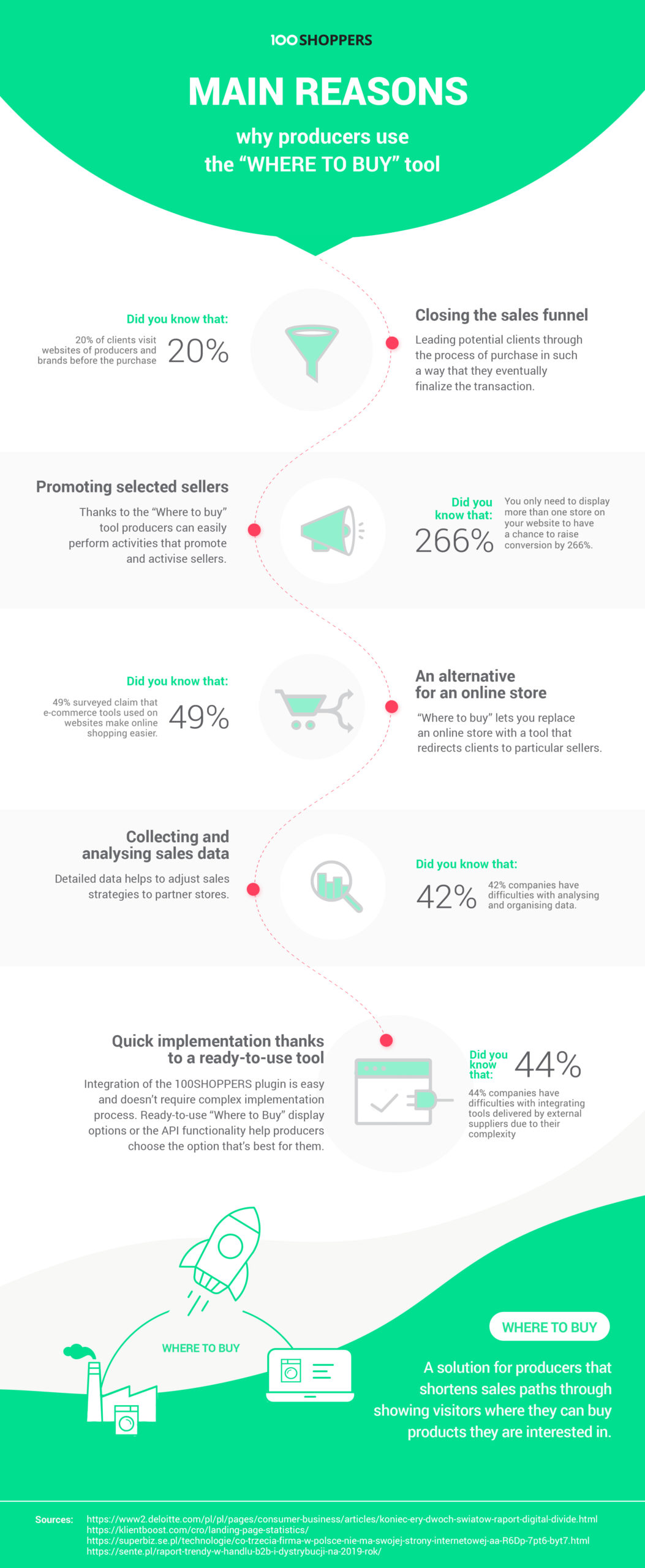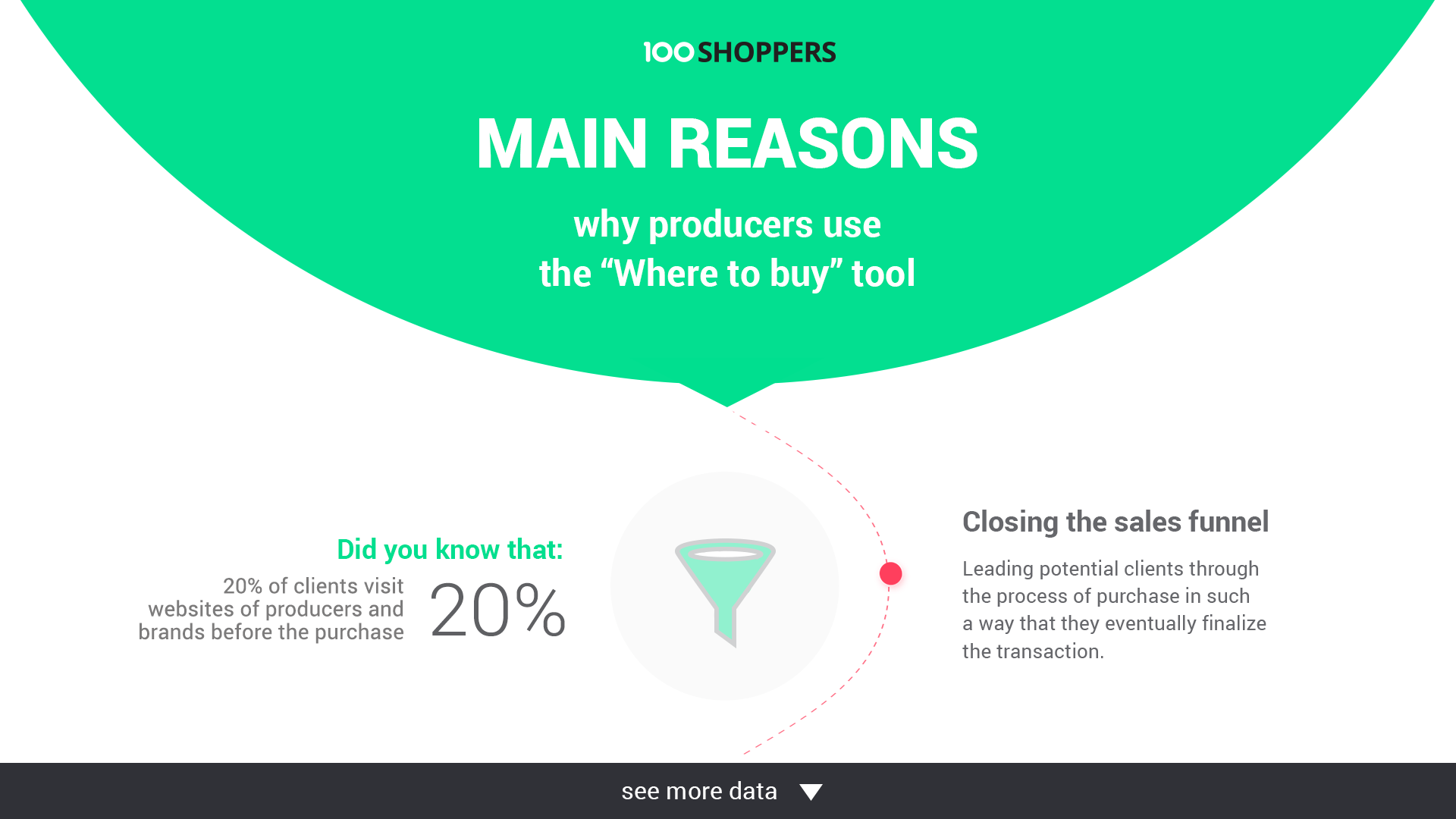Client’s path to purchase can be quite knotty at times. This is especially true in the omnichannel market environment, with off- and online channels intersecting on regular basis. The buyer’s interest is always centered around learning as much as possible about the product, its price, availability, or technical parameters. At the same time, customers want the purchase to be as swift and convenient as possible. For precisely those reasons more and more producers and retailers opt for the automation of processes, selecting solutions that simplify and shorten the path to purchase for specific channels. One of such solutions is our where to buy plugin.
Producer’s website as a source of information about a product
First of all, quite often producers choose not to set up their own online store for their products. Having your own e-shop could be problematic for many reasons, also because it might become a source of conflict between the producers themselves and the official sellers. Also, distributors might drop the idea of running their own online store for fear of it cannibalizing sales on the offline channel. However, not to overplay your hand, a website could still become a great touchpoint to generate leads and direct online traffic in a highly efficient manner.
Our shopping habits have been changing dramatically over the years, as have our paths to purchase, trends which have been described in a recent report prepared by the Deloitte auditing company. In ‘Navigating the new digital divide. Capitalizing on digital influence in retail in Poland, 2019’*, analysts characterize the modern buyer as one who has transformed from a smart-shopper into an interdependent specialist, acutely aware of their needs and expectations towards a purchase.
According to the report, even before they buy, as many as 48% of clients look for information about the product via in-store apps or, more generally, from a computer. It is the most common practice to begin your shopping with the price comparison engine. Clients start browsing through the offers, and it may happen that they come across our website. If they realize that the prices in official distribution are very similar across different sellers, this is precisely the moment where they can be reacquired and turned into leads. As the report states, 20% of respondents visit brand e-stores and producers’ websites. In fact, in an after-purchase survey, 49% of respondents declared that e-tools and solutions embedded on the websites greatly expedited their shopping.
Producer’s website as a lead generator
Sometimes producers don’t realize that they themselves wield the most powerful tool at their disposal on the quest for activating clients – their landing page. According to statistics published by KlientBoost*, if done right, our landing page can be a great aid to conversion. The data shows that sometimes simple steps, like including more that one offer on the page, are likely to boost conversion by as much as 266%(!). On the other hand, every second of delay in page load time equals a drop in conversion by 7%. Bearing in mind that the average conversion rate for a website is 2.35%, the highest being 5.31%, the 7% can be a sink or swim for many businesses. Additionally, as KlientBoost indicate, only 50% of landing pages are optimized for mobile devices. Furthermore, data provided by Eurostat shows that in 2016, still only 65% of Polish businesses put out a company website, which pushed Poland down to 23rd position among other European countries in terms of digitization*.
As we can see, producers can start losing clients quite quickly by operating from ill-adjusted landing pages, which have not been optimized with client-centricity in mind. Another reason for growing client drop out rate might be of technical nature. A report prepared by Sente in 2019, shows that 44% of businesses actually struggle with implementing solutions from outsourced providers, 42% limp through analyzing and categorizing client data, and 36% of companies find it hard to sort out channel outputs.
In order to become a thriving business in modern market environment, it is worth choosing comprehensive solutions – ones that analyze web traffic, at the same time monitoring official distributors, or directing clients to specific resellers, and, most of all, solutions that are easily implementable and user-friendly.

Producer’s website + outsourced solution
If properly implemented, instruments provided by third parties can effectively transform a website into an analytical and sales tool. One of such means is the plugin designed by 100Shoppers. To answer why producers choose this solution and what actionable metrics it provides, let’s take a look at the tool in action in a contextualized online setting.
Essentially, the where to buy instrument is a simple yet robust plugin, dedicated for company websites and main providers of products to a given market. The integration process for the tool is neat and hassle-free, and the code itself had been written in compliance with the highest market practices of “good coding and software”.
After implementation, every product description on producer’s website is automatically supplemented with additional information, containing not only product specification, but also a list of authorized online and offline dealers. An extensive control and analysis panel allows the user to gather and analyze sales data and traffic trends. Here are the key benefits for producers that come from launching the were to buy plugin:
- First and foremost, it closes the sales funnel. We know that the company website is among the first sources for the clients to visit while on a quest to make informed shopping decisions. The where to buy tool implemented here brings all the information facilitating the purchase right to buyer’s view. Beside technical specifications, the buyer can also check the price and availability with any given reseller. It is of essence, as online customers might not always be familiar with the official product distributors, or be able to tell genuine product from a knock-off. The where to buy plugin helps to dispel such doubts. More often than not, a visitor to a brand’s website does click the link that takes them to a seller, where the purchase is completed. In this way, the path to purchase is considerably shortened and streamlined. The innovative element of this solution is that the information about the purchase is available both for the distributor and the retailer. In that way, the former can anticipate which products will be in short supply in the nearest future, and the latter is able to compare his results against those of other resellers.
- It helps you incentivize selected sellers. If a producer cooperates with a number of official retailers at the same time, they’re bound to turn out different sales levels. Thanks to the where to buy tool, the producer can run an efficient and time-effective incentives program by, for example, lowering the prices on the purchase of goods, or by running periodical actions promoting one seller at a time.
- It is a viable alternative for an online store. For a vast number of reasons, not all producers resort to e-commerce solutions. The where to buy plugin works perfectly in place of an online store, as it directs the buyers straight to selected sellers. With the data gathered by this instrument, a comprehensive analysis can be carried out to, for example, identify the more and less popular retailers. Other valid information that can be skimmed from the data gathered by the plugin are average basket size, average order, products which are sold in bulk at each and every reseller. Not to mention that we can also learn about the influence of price or added values on clients’ shopping choices.
- It gathers and analyses complex sales data. Yet another essential reason why producers should consider choosing the where to buy tool is extensive but transparent analysis of clients’ behavior and sales volumes delivered by this plugin. Not only the already mentioned average basket size information, but also average visit duration, which products generate the highest number of clicks, time to conversion, etc. – all of those indicators can help you manage your sales pipelines better. Our tool provides fundamental numbers for drafting sales strategies for each of our official distributors, it can be used for singling out the most effective sellers, or running rewards and incentives programs.
Other reasons to choose the where to buy solution
Beside the principal functionalities already described, our plugin can also help you with identifying the consumer profile. It gathers information about clients’ preferred purchase channel – off- or online, monitors prices and product availability. What should be stressed is that the plugin itself becomes an additional touchpoint between clients and brands. Issues that are taken into consideration by the producer while deciding on a tool are usually the size and type of assortment they have on offer and the target group for their products. With this one tool the producer can do all that and, in a time- and cost-effective manner, organize a comprehensive and meticulous strategy at any moment, from any place, with all the necessary data at hand. In the omnichannel approach to sales it seems that choosing the where to buy tool is not only a truly efficient solution – it is also a highly smart one.
Sources:
- Deloitte Report ‘Navigating the new digital divide’: https://www2.deloitte.com/us/en/pages/consumer-business/articles/navigating-the-new-digital-divide-retail.html
- data available in Polish: https://sente.pl/raport-trendy-w-handlu-b2b-i-dystrybucji-na-2019-rok/
- data available in Polish: https://superbiz.se.pl/technologie/co-trzecia-firma-w-polsce-nie-ma-swojej-strony-internetowej-aa-R6Dp-7pt6-byt7.html








